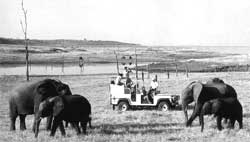Wild at home
 in zimbabwe, the number of wild animals is growing, not as a consequence of conservation but of utilisation. Zimbabwe's game and nature reserves cover 13 per cent of the country's total surface area. But wildlife is also extensively managed on twice as much land on private farms, cattle ranches and the traditional communal lands belonging to the indigenous people.
in zimbabwe, the number of wild animals is growing, not as a consequence of conservation but of utilisation. Zimbabwe's game and nature reserves cover 13 per cent of the country's total surface area. But wildlife is also extensively managed on twice as much land on private farms, cattle ranches and the traditional communal lands belonging to the indigenous people.
Underlying all this is a new nature conservation policy, which can be called game or wildlife farming. The seeds for this were sown 22 years ago by an amendment to the wildlife legislation. "Prior to this, wildlife belonged to the state and had no value for the landowner. Therefore, it was not looked after and a lot of wildlife was wiped out in favour of domestic stock. All this changed in 1975.The decision was one of the most important moves in southern Africa," says John White, chief executive officer of Zimbabwe's Wildlife Producers Association (wpc).
"Once the people in the countryside started to benefit from the wild animals, they no longer saw them as a nuisance but as a source of livelihood, and so began to take care of them," says Willas Makombe, acting director of the department of national parks and wildlife management. "Game farming has had a dramatic impact on the environment. The wild animals are returning to areas from which they were at one time expelled," says Mike Hitschman, past-president of the Wildlife Society of Zimbabwe.
Tough but easy to handle Farming wild animals is not a new idea. What is interesting is its scale and the high degree of success. One of the earliest to experiment in Zimbabwe was Norman Travers, who owns the Imire game ranch near Harare. "I brought a few animals to my farm in 1972 on an experimental basis and fenced off an area to see what would happen. That is how it all began," he says. "In principle, keeping cattle, sheep or wild animals is all the same, but of course, you have to know how to handle them. Compared to cattle, wildlife has a lot of advantages, such as a built-in tolerance to drought, tsetse flies and ticks." Now, almost a thousand large game animals roam his farm. The farm's special treasures are seven black rhinos. These belong to the state but live here under special protection, guarded by six armed wardens day and night. Due to heavy poaching, there are now only 300 or so black rhinos left in Zimbabwe, compared to a couple of thousand just a few years ago.
Game farms and ranches are also very important to the conservation of endangered animals. "Cattle was brought to Africa from outside and wild animals were forced off farms because domestic animals were easily manageable. But now people have seen that wildlife can use the vegetation much better than the cattle. So why shouldn't we utilise our own wild animals?" argues White. "The game farmer has a vertical acre instead of a horizontal one - a wide variety of animals from the giraffe eating leaves off the tops of trees to the warthog digging roots in the ground," he adds. There are now more than 300 game farms and ranches in Zimbabwe. They range in size from a few thousand to hundreds of thousands of hectares.
Wildlife auctions are also conducted to help farmers either wishing to become game farmers or to increase their variety of species. These auctions are arranged by wpc from June to September.
Apart from farms and ranches, a large area is also taken up by communal lands belonging to the indigenous people. The nature-oriented use of such lands is extremely important from the conservation perspective. A campfire (Communal Areas Management Programme for Indigenous Resources) programme was launched on communal lands, in 1989, which promotes the use of local natural resources, such as wild animals, as an economically sound and sustainable land use option. The villagers benefit from their conservation efforts either directly in the form of meat, or indirectly by eco-tourism incomes.
The department of national parks and wildlife management defines annual game hunting quotas and the villages and districts themselves decide how to make use of these. The hunters also provide employment. "One hunter may directly or indirectly provide work for 50 people: guides, trackers, camp builders, bearers and cooks," explains Keith Hopkins, who heads a private consultancy hunting firm. The money gathered is often channelled into the construction of schools, hospitals and grinding mills.
Johnson Siamachira is a communications officer at the Intermediate Technology Development Group, Harare
Related Content
- Report of the Comptroller and Auditor General of India on performance audit of protection, conservation and management of wildlife sanctuaries in Gujarat
- Project tiger: 50 years of tiger conservation in India
- Skin and bones: tiger trafficking analysis from January 2000–June 2022
- Summary for policymakers of the thematic assessment of the sustainable use of wild species
- The critical need for elephant reserves
- Skin and bones unresolved: an analysis of tiger seizures from 2000-2018
